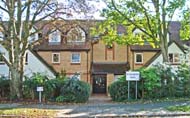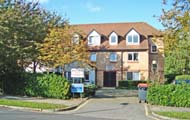St
Elizabeth's Home
Mayfield Avenue, North Finchley, N12 9HZ
Medical
dates:
Medical
character:
Rehabilitation (geriatric)
In the second half of the 19th century the Society of All Saints Sisters of the Poor
opened a second home for incurables in Mayfield Avenue. It was
named St Elizabeth's Home, as indeed was its first such home which had
opened in Mortimer Street in 1856.
In 1952 the Sisterhood moved to Seaford in East Sussex. The building was then bought by the Barnet Group Hospital Management Committee to extend its geriatric service.
St Elizabeth's Home was officially opened by Sir Fred Messer, C.B.E., J.P., M.P., in March 1953 as an NHS facility for elderly females under the care of the Barnet Group geriatrician. It had 53 beds, shared equally between the Barnet and Hendon Groups. The Home was intended to be a halfway house for geriatric patients who would not be retained indefinitely but until they could be discharged home, or to Part III accommodation (for aged, non-sick residents under Part III of the National Assistance Act, 1948) or returned to hospital.
During the first year most patients stayed in bed, but eventually were encouraged to get up and dressed. This, however, revealed a serious shortage of sitting space within the Home. The sitting room, adequate for 25 patients, had to accommodate 40 in winter when the bad weather made the garden inaccessible. Chairs were arranged in a row around the walls, with two rows down the middle of the room. The room was also bleak, with no pictures on the walls. To solve the seating problem, a new sitting room was built for £500. It was attached to one ward and jutted out into the garden.
The kitchen was on a different level to the rest of the building, making it inconvenient for the delivery of food to the dining room.
The nursing staff lived on the top floor but, although the rooms had central heating, they had no wash basins.
During the 1960s plans were made to extend the Home, but these came to naught.
The Home continued as a rehabilitation centre for elderly female patients who were helped to walk again and regain a degree of independence. It also provided respite care, that is, short-term holiday admissions to enable carers to have a summer holiday.
By 1974 the Home had 40 beds, but its facilities were old-fashioned and difficult to maintain. It had no lift and infirm patients had to be carried manually up and down the spiral staircase. It finally closed in 1979.
Present status (October 2008)
In 1952 the Sisterhood moved to Seaford in East Sussex. The building was then bought by the Barnet Group Hospital Management Committee to extend its geriatric service.
St Elizabeth's Home was officially opened by Sir Fred Messer, C.B.E., J.P., M.P., in March 1953 as an NHS facility for elderly females under the care of the Barnet Group geriatrician. It had 53 beds, shared equally between the Barnet and Hendon Groups. The Home was intended to be a halfway house for geriatric patients who would not be retained indefinitely but until they could be discharged home, or to Part III accommodation (for aged, non-sick residents under Part III of the National Assistance Act, 1948) or returned to hospital.
During the first year most patients stayed in bed, but eventually were encouraged to get up and dressed. This, however, revealed a serious shortage of sitting space within the Home. The sitting room, adequate for 25 patients, had to accommodate 40 in winter when the bad weather made the garden inaccessible. Chairs were arranged in a row around the walls, with two rows down the middle of the room. The room was also bleak, with no pictures on the walls. To solve the seating problem, a new sitting room was built for £500. It was attached to one ward and jutted out into the garden.
The kitchen was on a different level to the rest of the building, making it inconvenient for the delivery of food to the dining room.
The nursing staff lived on the top floor but, although the rooms had central heating, they had no wash basins.
During the 1960s plans were made to extend the Home, but these came to naught.
The Home continued as a rehabilitation centre for elderly female patients who were helped to walk again and regain a degree of independence. It also provided respite care, that is, short-term holiday admissions to enable carers to have a summer holiday.
By 1974 the Home had 40 beds, but its facilities were old-fashioned and difficult to maintain. It had no lift and infirm patients had to be carried manually up and down the spiral staircase. It finally closed in 1979.
Present status (October 2008)
In May 1984 the building was sold for £1,075,325 to developers, who proposed to erect a much larger retirement home on the site. Vociferous opposition by the local residents prevented this, on the grounds it would not be in keeping with the scale of the other properties in the area.
The Home was completely demolished, despite its chapel being protected by a Covenant, and rebuilt in 1988 as retirement homes. St Elizabeth's Court (in Mayfield Avenue) and Homan Court (in Friern Watch Avenue) are linked by a conservatory walkway through the communal gardens.

St Elizabeth's Court in Mayfield Avenue.

Homan Court in Friern Watch Avenue, which runs parallel to Mayfield Avenue, is named after the businessman and local benefactor Ebenezer Homan, J.P., a former President of the Finchley Cottage Hospital.
The Society was
founded in 1851 in London by Harriet
Brownlow Byron (1818-1887), one of the first Anglican Sisterhoods
to be established.
In September 1851 she acquired a house in Mortimer Street and moved in on 18th October 1851, this date later becoming the Foundation Day for the All Saints Sisters of the Poor.
On 27th December 1851 she was joined by Sarah Easton - and this was the beginning of the community. The chief religious vocation of the Sisterhood was 'to provide a Religious Asylum for aged and infirm persons in destitute circumstances'.
The first years of the community were spent helping and caring for the needy, but gradually more helpers joined. On 5th May 1856 Harriet Brownlow Byron, Sarah Easton and Ellen Wilson were professed by Revd William Upton Richards (1811-1873), the first vicar of All Saints Church in Margaret Street.
On 3rd August 1856 the Society elected Harriet Brownlow Byron as a 'Mother for Life'. On the following day the community - Sisters, girls in training, orphans, elderly women and incurables - moved to new premises - All Saints Home - in Margaret Street. The house in Mortimer Street was named St Elizabeth's Home for Incurables.
From 1862 until 1899 the Sisters undertook responsibility for the nursing care and training at University College Hospital.
The community continued to expand and a dispensary was established for poor people to obtain medical care. The mortuary chapel received the dead before burial.
As the century progressed the Sisterhood established hospitals for incurables in Eastbourne, North Finchley and Seaford. In 1881 they took over the nursing care at St John's Home in Oxford. The Sisters also went to the United States, South Africa and India, working with missions run by the Society of St John the Evangelist.
As national and local authorities began to provide welfare services during the 20th century, the Society decided to moved its Mother House to Oxford in 1976.
The community initiated a number of projects, which are now run as independent charities, including Helen House (the world's first hospice for children), Douglas House (a hospice for young adults aged from 16 to 35) and the Steppin' Stone Porch Centre (a drop-in centre for homeless people).
St John's Home, a residential care home for the elderly, is located in the grounds of the Society's Mother House.
In September 1851 she acquired a house in Mortimer Street and moved in on 18th October 1851, this date later becoming the Foundation Day for the All Saints Sisters of the Poor.
On 27th December 1851 she was joined by Sarah Easton - and this was the beginning of the community. The chief religious vocation of the Sisterhood was 'to provide a Religious Asylum for aged and infirm persons in destitute circumstances'.
The first years of the community were spent helping and caring for the needy, but gradually more helpers joined. On 5th May 1856 Harriet Brownlow Byron, Sarah Easton and Ellen Wilson were professed by Revd William Upton Richards (1811-1873), the first vicar of All Saints Church in Margaret Street.
On 3rd August 1856 the Society elected Harriet Brownlow Byron as a 'Mother for Life'. On the following day the community - Sisters, girls in training, orphans, elderly women and incurables - moved to new premises - All Saints Home - in Margaret Street. The house in Mortimer Street was named St Elizabeth's Home for Incurables.
From 1862 until 1899 the Sisters undertook responsibility for the nursing care and training at University College Hospital.
The community continued to expand and a dispensary was established for poor people to obtain medical care. The mortuary chapel received the dead before burial.
As the century progressed the Sisterhood established hospitals for incurables in Eastbourne, North Finchley and Seaford. In 1881 they took over the nursing care at St John's Home in Oxford. The Sisters also went to the United States, South Africa and India, working with missions run by the Society of St John the Evangelist.
As national and local authorities began to provide welfare services during the 20th century, the Society decided to moved its Mother House to Oxford in 1976.
The community initiated a number of projects, which are now run as independent charities, including Helen House (the world's first hospice for children), Douglas House (a hospice for young adults aged from 16 to 35) and the Steppin' Stone Porch Centre (a drop-in centre for homeless people).
St John's Home, a residential care home for the elderly, is located in the grounds of the Society's Mother House.
References
Holloway SWF 1959 The All Saint's Sisterhood at University College Hospital, 1862-1899. Medical History 3, 146-156.
www.ssmjchurchyard.org
www.stjohnshome.org.uk
Holloway SWF 1959 The All Saint's Sisterhood at University College Hospital, 1862-1899. Medical History 3, 146-156.
www.ssmjchurchyard.org
www.stjohnshome.org.uk
Personal communication: Mrs S.J. Renton.
http://hansard.millbanksystems.com
http://roamincatholicphiladelphia.blogspot.com
www.british-history.ac.uk
Return to home page